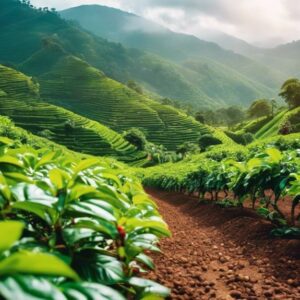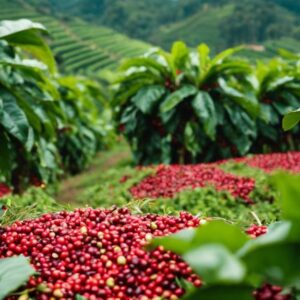Have you ever wondered if you could grow your own Arabica coffee at home?
The process might be simpler than you think. By following a few easy steps, you could soon be sipping on coffee made from beans you cultivated yourself.
But before you get ahead of yourself, let’s take a moment to consider the first crucial step in this exciting journey.
How to Grow Arabica Coffee?
To successfully grow Arabica coffee, you need to consider genetic diversity for robust cultivation.
Seek out ideal microclimates that support optimal Arabica production.
Implement advanced cultivation techniques to ensure premium quality beans for your coffee.
Genetic Diversity and Its Impact on Cultivation
When cultivating Arabica coffee, understanding the genetic diversity is crucial for success. Here are three key points to consider:
- Explore Arabica’s various genetic varieties for a world of flavors.
- Recognize the significance of genetics in enhancing disease resistance.
- Genetic diversity plays a crucial role in maximizing yield potential.
Exploring Arabica’s Genetic Varieties: A World of Flavor
Exploring the diverse genetic varieties of Arabica coffee enhances its cultivation by fostering a world of flavor.
Arabica’s genetics play a crucial role in shaping the taste profiles of coffee beans. From the fruity and floral notes of Bourbon variety to the chocolatey richness of Typica, each variety offers a unique sensory experience.
Understanding these genetics can help you cultivate coffee with exceptional flavors.Variety Flavor Profile Origin Bourbon Fruity, Floral Ethiopia Typica Chocolatey Jamaica Geisha Citrusy, Tea-like Panama
The Role of Genetics in Disease Resistance and Yield
Understanding the genetic diversity of Arabica coffee plays a crucial role in enhancing disease resistance and yield in cultivation. Utilizing hybrids can introduce beneficial traits like pest resistance, leading to higher yields.
The Ideal Microclimates for Arabica Production
When growing Arabica coffee, it’s vital to understand how microclimates impact the quality of your beans. To ensure optimal conditions for cultivation, consider the following:
- Elevation: Choose high altitudes of around 1200-1800 meters above sea level.
- Temperature: Aim for a consistent temperature range of 15-24°C.
- Shade: Provide ample shade, ideally from taller trees or structures.
Understanding Microclimate Effects on Bean Quality
Choosing the right microclimates plays a crucial role in enhancing the quality of Arabica coffee beans. To optimize bean quality, consider these factors:
- Temperature: Ensure a consistent, moderate temperature range.
- Humidity: Maintain adequate moisture levels without excess humidity.
- Sunlight: Provide filtered sunlight to prevent scorching.
These elements impact the microclimate and consequently influence the flavor profile of your coffee beans.
Creating Optimal Conditions in Your Garden or Farm
To cultivate premium Arabica coffee beans successfully, ensure your garden or farm maintains the ideal microclimates for optimal production.
- Implement shade trees to protect delicate coffee plants from harsh sunlight.
- Provide consistent moisture levels by utilizing drip irrigation systems.
- Maintain a temperature range between 60-70°F to promote healthy growth and bean development.
Advanced Cultivation Techniques for Premium Quality
When aiming for premium quality Arabica coffee, it’s crucial to master advanced cultivation techniques. You can achieve this by focusing on shade management to optimize light exposure and prioritizing soil health through organic matter. These practices are essential for enhancing the flavor and quality of your coffee beans.
| Shade Management | Soil Health |
|---|---|
| Balancing Light for Optimal Growth | Organic Matter and Microbial Activity |
Shade Management: Balancing Light for Optimal Growth
For optimal growth of Arabica coffee plants, ensuring a careful balance of shade to light exposure is crucial. To manage shade effectively:
- Utilize shade trees strategically to filter sunlight.
- Implement adjustable shade structures for flexibility.
- Monitor light intensity regularly to optimize growth conditions.
Soil Health: Organic Matter and Microbial Activity
To optimize the growth of your Arabica coffee plants and ensure premium quality, focus on maximizing soil health through organic matter enrichment and promoting microbial activity.
Enhance your soil by:
- Incorporating compost or manure to boost organic matter content.
- Introducing beneficial microbes through organic fertilizers.
- Implementing crop rotation to maintain soil biodiversity and microbial activity.
Preparing for Your Arabica Coffee Journey
Before embarking on your Arabica coffee journey, remember that site selection is crucial for a thriving garden.
Take the time to prepare and improve the soil, as it sets the foundation for your coffee plants’ success.
Proper water management is essential to ensure your coffee plants stay adequately hydrated throughout their growth.
Site Selection: The First Step to a Thriving Coffee Garden
When selecting a site for your coffee garden, focus on evaluating the land based on climate, elevation, and soil type. Consider design elements such as layout and accessibility to ensure a successful coffee-growing environment. Remember, a thriving coffee garden begins with choosing the right location.
- Evaluate Land for Climate
- Assess Elevation
- Consider Soil Type
Evaluating Land for Climate, Elevation, and Soil Type
Evaluating the land for climate, elevation, and soil type is crucial when preparing for your Arabica coffee journey, as these factors significantly impact the success of your coffee garden. Ensure the climate suits Arabica growth, consider ideal elevations of 2,000-6,000 feet, and assess soil type for good drainage and nutrient retention.
Use the table below to help evaluate your land effectively.
| Factors to Evaluate | Importance Level |
|---|---|
| Climate Suitability | High |
| Elevation Range | Medium |
| Soil Drainage | High |
| Nutrient Retention | High |
Design Considerations: Layout and Accessibility
Considering the optimal layout and accessibility of your coffee garden is essential for maximizing productivity and ease of management. To ensure a well-designed space, focus on:
- Layout: Plan for efficient use of space, incorporating pathways for easy navigation.
- Spacing: Allow adequate room between coffee plants for proper growth and maintenance.
- Accessibility: Ensure pathways are wide enough for equipment and easy harvesting access.
The Foundation of Success: Soil Preparation and Improvement
Before diving into planting your Arabica coffee, let’s focus on laying the groundwork for success. Make sure to test and adjust the soil pH to meet the needs of your Arabica plants.
Enhance soil fertility naturally by incorporating organic amendments.
POINTS:
- Test and Adjust Soil pH for Arabica Plants
- Organic Amendments: Enhancing Soil Fertility Naturally
Testing and Adjusting Soil pH for Arabica Plants
To ensure optimal growth for your Arabica plants, it’s essential to test and adjust the soil pH accordingly.
- Test pH Levels: Use a pH meter to determine the acidity or alkalinity of the soil.
- Adjust pH: Add organic materials like compost or peat moss to modify pH levels.
- Monitor Watering: Ensure proper watering practices to maintain the pH balance and promote healthy plant growth.
Organic Amendments: Enhancing Soil Fertility Naturally
Enhancing soil fertility naturally involves incorporating organic amendments to enrich the soil for optimal Arabica coffee growth.
- Compost: Adds essential nutrients and improves soil structure.
- Manure: Boosts soil fertility and enhances microbial activity.
- Cover Crops: Prevents erosion, adds organic matter, and fixes nitrogen naturally.
Water Management: Ensuring Adequate Hydration
When it comes to ensuring your Arabica coffee plants receive the right amount of hydration, you’ll want to focus on these key points:
- Implementing effective irrigation techniques to optimize water usage.
- Utilizing mulching and other methods to help the soil retain moisture.
- Monitoring the hydration levels closely to maintain the health of your coffee plants.
Irrigation Techniques for Efficient Water Use
Implementing efficient irrigation techniques is crucial for maximizing water utilization in your Arabica coffee plantation. To ensure efficient water use, consider the following techniques:
- Drip irrigation systems deliver water directly to the plant roots, reducing water wastage.
- Utilize moisture sensors to accurately determine when watering is needed.
- Implement rainwater harvesting methods to supplement irrigation and reduce reliance on external water sources.
Mulching and Other Strategies to Retain Soil Moisture
To further optimize water retention in your Arabica coffee plantation, incorporating mulching and other soil moisture retention strategies is essential. Here are key strategies to retain soil moisture effectively:
- Mulch around the coffee plants to reduce moisture evaporation.
- Utilize cover crops to protect the soil and maintain moisture levels.
- Implement drip irrigation systems for targeted and efficient watering.
Cultivating Your Arabica Coffee Plant
Now, it’s time to focus on cultivating your Arabica coffee plant.
During the seedling stage, it’s crucial to provide the right care for your plants to ensure their growth.
Implementing effective planting strategies and managing growth techniques will set the foundation for a healthy and thriving coffee plant.
The Seedling Stage: A Critical Period for Arabica Plants
When cultivating your Arabica coffee plant, the seedling stage is a critical period that requires your attention. To ensure successful growth, focus on providing optimal conditions for your seedlings and transitioning them effectively from the nursery to the field.
Here are three key points to keep in mind during this crucial stage:
- Optimal Conditions for Seedling Growth and Development
- Regular Monitoring and Care for Healthy Seedlings
- Proper Techniques for Transitioning Seedlings from Nursery to Field
Optimal Conditions for Seedling Growth and Development
During the seedling stage of cultivating your Arabica coffee plant, maintaining optimal conditions is crucial for the growth and development of your plant. To ensure success, consider the following:
- Proper Germination: Provide adequate moisture and warmth for efficient seed germination.
- Nutrient-Rich Soil: Use nutrient-rich soil to support healthy seedling growth.
- Ample Sunlight: Ensure your seedlings receive sufficient sunlight for photosynthesis and overall vitality.
Transitioning Seedlings from Nursery to Field
Transition your healthy Arabica coffee seedlings from the nursery to the field for continued growth and maturation.
- Planting: Choose a sunny, well-drained location for optimal growth.
- Setup: Prepare the field by clearing weeds and ensuring proper spacing between plants.
- Care: Water regularly, provide shade if needed, and monitor for pests to ensure your Arabica coffee plants thrive in their new environment.
Planting Strategies for Long-Term Success
When cultivating your Arabica coffee plant, you should consider the following points for long-term success:
- Spatial Arrangement: Understand plant density and how it affects growth.
- Companion Planting: Explore synergies with other crops to enhance coffee plant health.
- Soil Health: Maintain soil fertility and structure for optimal coffee plant growth.
Spatial Arrangement: Understanding Plant Density and Its Effects
To ensure optimal growth and productivity of your Arabica coffee plants, understanding plant density and its effects is crucial for successful cultivation. Consider the following when planning your planting strategy:
- Spacing: Proper spacing between coffee plants allows for adequate light penetration and airflow.
- Planting: Ensure each coffee plant is placed strategically to maximize growth potential.
- Density: Balancing plant density is key to promoting healthy development and yield.
Companion Planting: Synergies with Other Crops
Understanding how companion planting with other crops can benefit your Arabica coffee plants is crucial for maximizing their growth potential and long-term success. By strategically choosing plants that complement each other, you can create synergies that enhance soil health, pest control, and overall crop yield.
Consider the following table for some innovative companion planting ideas:Crop Synergistic Benefit Legumes Fix nitrogen in soil Marigolds Repel pests Citrus trees Provide shade Basil Improve flavor Nasturtiums Attract beneficial insects
Managing Growth: Techniques for a Healthy Coffee Plant
When cultivating your Arabica coffee plant, you need to focus on techniques that promote healthy growth and development. To ensure your plant thrives, consider the following:
- Staking and Support: Guide young plants to help them grow upright and strong.
- Inter-cropping: Enhance soil quality and plant health by planting complementary crops alongside your coffee plants.
- Regular pruning: Maintain the shape and health of your coffee plant by trimming away dead or overgrown branches.
Staking and Support: Guiding Young Plants
As you nurture your young Arabica coffee plants, providing staking and support is essential for guiding their growth and ensuring their health. Consider these innovative techniques:
- Prune regularly: Trim excess branches to promote healthy growth.
- Utilize sturdy stakes: Support young plants with reliable stakes for proper alignment.
- Guide with care: Gently train the plant along the stake to encourage upward growth.
Inter-cropping: Benefits for Soil and Plant Health
Inter-cropping can significantly enhance the soil quality and overall health of your Arabica coffee plants. By diversifying plant species in your coffee plantation, you can promote soil health, reduce pests, and improve nutrient absorption.
This innovative technique fosters a balanced ecosystem, benefiting both your coffee plants and the environment.
Embrace inter-cropping to maximize the potential of your Arabica coffee plants for optimal growth and vitality.
The Care and Keeping of Arabica Coffee

Now that your Arabica coffee plant is in the ground, it’s crucial to focus on its care and maintenance.
You’ll need to pay attention to integrated nutrient management, ensuring your plant receives the necessary food for healthy growth.
Additionally, mastering the art of pruning will help shape your Arabica for maximum yield.
Integrated Nutrient Management: Feeding Your Coffee Plants
When it comes to feeding your coffee plants, you need to consider the type of fertilizer you use. Here are some key points to keep in mind:
- Synthetic vs. Organic Fertilizers: Understand the pros and cons of each.
- Custom Fertilization Plans: Tailor your approach based on soil testing results.
- Balanced Nutrient Supply: Ensure your coffee plants receive all the necessary nutrients for healthy growth.
Synthetic vs. Organic Fertilizers: Pros and Cons
To effectively nourish your Arabica coffee plants, consider the advantages and disadvantages of using synthetic versus organic fertilizers. When deciding on a fertilization method, it’s essential to weigh the benefits of each. While synthetic fertilizers provide quick nutrients, organic fertilizers foster soil health and long-term sustainability.
Here’s a comparison table to help you make an informed choice:
| Factors | Synthetic Fertilizers | Organic Fertilizers |
|---|---|---|
| Nutrient availability | High | Moderate |
| Soil health | Decreases | Increases |
| Environmental impact | Negative | Positive |
Custom Fertilization Plans Based on Soil Testing
For custom fertilization plans tailored to your Arabica coffee plants based on soil testing, consider consulting with agricultural experts for optimal nutrient management.
Here are some innovative approaches to nutrient amendment:
- Utilize precision fertilizers to target specific nutrient deficiencies.
- Implement controlled-release fertilizers for gradual nutrient release.
- Consider organic nutrient sources for sustainable soil health.
The Art of Pruning: Shaping Your Arabica for Maximum Yield
When it comes to shaping your Arabica coffee plant for optimal yield, you’ll want to master the art of pruning. Follow these key points to ensure your plant grows healthy and productive:
- Pruning Techniques for Different Growth Stages
- The Timing of Pruning: Seasonal Best Practices
Pruning Techniques for Different Growth Stages
Prune your Arabica coffee plant according to its growth stage to optimize yield and health. For young plants, focus on shaping and promoting strong root development. In mature plants, prioritize removing weak or diseased branches to enhance productivity.
Consider these techniques based on growth stages:Growth Stage Pruning Technique Young Shaping for root development Mature Removing weak or diseased branches
The Timing of Pruning: Seasonal Best Practices
To maximize your Arabica coffee plant’s yield and health, understanding the seasonal best practices for pruning is crucial.
Follow these seasonal pruning practices:
- Spring: Trim back any dead or damaged branches to encourage new growth.
- Summer: Shape the plant by pruning to maintain its desired size and structure.
- Fall: Cut back on excessive growth to prevent overcrowding and promote better airflow.
Disease and Pest Control: Keeping Your Plants Healthy
When it comes to caring for your Arabica coffee plants, keeping them healthy is crucial. By utilizing organic solutions for common pests and diseases, you can ensure the well-being of your plants. Monitoring and early detection are key strategies in maintaining a thriving coffee crop.
| Organic Solutions for Common Arabica Pests and Diseases | Monitoring and Early Detection: Preventative Care Strategies |
|---|---|
| Neem oil – Effective against aphids and mites | Regularly inspecting leaves for signs of discoloration |
| Beneficial nematodes – Combat soil-dwelling pests | Setting up pheromone traps to monitor insect populations |
| Garlic spray – Repels many insects | Keeping a close eye on plant growth patterns |
| Copper fungicide – Controls fungal infections | Recording any changes in plant appearance |
Organic Solutions for Common Arabica Pests and Diseases
For safeguarding your Arabica coffee plants against common pests and diseases, consider implementing organic solutions for optimal health and growth.
- Neem Oil: Acts as a natural insecticide, controlling pests like aphids and mites.
- Garlic Spray: Repels insects and combats fungal diseases.
- Beneficial Insects: Introduce ladybugs or lacewings to predate on harmful pests, aiding in natural pest control.
Monitoring and Early Detection: Preventative Care Strategies
Stay vigilant and proactive in monitoring your Arabica coffee plants for early signs of pests and diseases to maintain their health and vitality.
Utilize smart sensors for real-time monitoring of plant health metrics.
Implement drone technology for aerial surveys to detect issues before they spread.
Embrace AI-powered apps that analyze leaf discoloration patterns for early disease detection.
Harvest Preparation: Anticipating the Fruits of Your Labor
As you anticipate the fruits of your labor in harvesting your Arabica coffee, there are crucial steps to consider for optimal results. To ensure the best bean quality, you must pay close attention to signs of ripeness and harvest at the right time. Here are the key points to keep in mind:
- Pre-Harvest Management: Ensuring Bean Quality
- Understanding the Signs of Ripeness
- Optimal Harvest Times
Pre-Harvest Management: Ensuring Bean Quality
To ensure high bean quality during the pre-harvest stage, it’s crucial to closely monitor the ripeness of the coffee cherries.
- Employ innovative methods for processing coffee cherries.
- Implement quality control measures to maintain the integrity of the beans.
- Utilize technology to optimize the harvest and ensure top-notch bean quality.
Understanding the Signs of Ripeness and Optimal Harvest Times
Monitoring the ripeness of coffee cherries is essential to ensure optimal harvest times and maintain the quality of Arabica coffee beans. To identify the perfect time for harvesting, look for these signs:
- Color: Ripe cherries are usually a deep red.
- Texture: The skin should be firm and smooth.
- Taste: A sweet, fruity flavor indicates ripeness.
Keep an eye out for these indicators to harvest your coffee cherries at their peak!
Overcoming Challenges in Arabica Coffee Cultivation

When growing Arabica coffee, you’ll face challenges like adapting to climate change, which requires innovative solutions to thrive.
Cultivation innovations are crucial to overcoming obstacles and finding success in the ever-evolving coffee market.
Navigating the economics of coffee production demands a strategic approach to ensure sustainability and profitability.
Climate Change: Adapting to an Evolving Environment
Amidst the shifting climate patterns, Arabica coffee growers face the challenge of adapting to an evolving environment to ensure the continued success of their cultivation efforts. Climate change poses a significant threat, requiring innovative adaptation strategies to maintain high-quality coffee production.
Embracing new technologies, such as advanced irrigation systems and shade management techniques, can help mitigate the impact of climate change on Arabica coffee crops. Additionally, implementing sustainable practices like agroforestry and soil conservation not only aids in adaptation but also promotes environmental resilience.
Innovations in Cultivation: Paving the Way Forward
To overcome challenges in Arabica coffee cultivation, embracing innovative techniques is key to paving the way forward for growers. Sustainable practices and cutting-edge innovations in cultivation are revolutionizing the coffee industry.
Implementing sustainable farming methods not only ensures the longevity of coffee production but also promotes environmental conservation. Innovations such as precision agriculture, where technology is used to optimize inputs like water and fertilizers, are enhancing crop yield and quality.
Additionally, advancements in pest and disease management are crucial for maintaining healthy coffee plants. By staying at the forefront of these cultivation innovations, growers can overcome obstacles and secure a prosperous future for Arabica coffee production.
Embrace sustainability and the latest cultivation techniques to thrive in this ever-evolving industry.
Market Dynamics: Navigating the Economics of Coffee Production
Navigating the economics of coffee production in Arabica cultivation requires a strategic understanding of market dynamics to overcome challenges effectively.
In the ever-evolving landscape of coffee production, staying ahead means grasping the intricate web of market forces that impact every stage of the process.
By immersing yourself in the nuances of market dynamics, you can unlock opportunities for growth and sustainability. Keep a keen eye on pricing trends, consumer preferences, and global demand shifts to make informed decisions that drive your production forward.
Embracing innovative approaches to address economic challenges can set you apart in a competitive market.
Ultimately, mastering the economics of coffee production isn’t just about growing beans; it’s about cultivating success in a dynamic industry.
Conclusion
Congratulations, you’re now a coffee farmer!
Just remember, growing Arabica coffee isn’t for the faint of heart.
But with a little love, care, and a whole lot of caffeine, you’ll have a thriving coffee plant in no time.
So go forth, coffee connoisseur, and may your beans be forever roasted to perfection.
Happy planting!
























